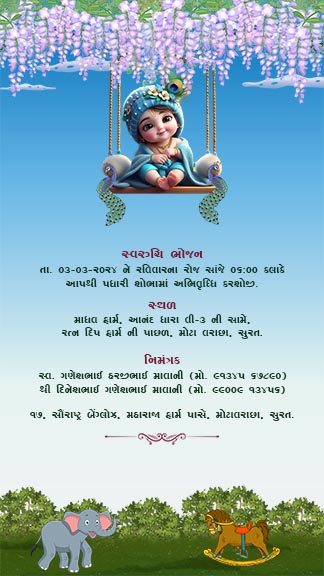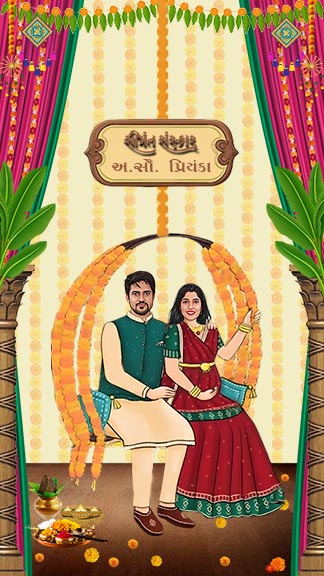Introduction
Seemantham is a traditional Indian ceremony celebrated with great enthusiasm and cultural reverence. The invitation to this special event plays a crucial role in setting the tone and ensuring that all the guests understand the significance of the occasion. Crafting the perfect Seemantham invitation in English requires attention to detail, respect for traditions, and a touch of creativity.
Understanding Seemantham
Historical Background
Seemantham, also known as Pumsavana Seemantham, is an ancient Hindu ritual performed during the seventh month of pregnancy. It is a part of the Vedic rites aimed at ensuring the well-being of the mother and the unborn child. This ceremony has been passed down through generations and holds a significant place in Indian culture.
Cultural Significance
The Seemantham ceremony is believed to bless the pregnant woman and her baby, ensuring a safe delivery and a healthy child. It is also an opportunity for family and friends to gather, offer blessings, and celebrate the impending arrival of a new family member.
Modern Practices
While the essence of Seemantham remains unchanged, modern practices have adapted to contemporary lifestyles. The ceremony now often includes a blend of traditional rituals and modern celebrations, making it an event that honors the past while embracing the present.

Why Seemantham Invitations Matter
Setting the Tone
An invitation is the first glimpse guests have of the upcoming event. A well-crafted Seemantham invitation sets the tone for the ceremony, reflecting its significance and the joyous atmosphere of the occasion.
Conveying Respect and Tradition
Seemantham invitations in English must convey respect for the traditions and customs associated with the ceremony. The wording, design, and overall presentation should honor the cultural heritage while being accessible to all guests.
Importance of Language and Wording
Using the right language and wording in the invitation is crucial. It should be clear, respectful, and appropriate for the occasion, ensuring that all guests understand the importance of their presence at the event.
Components of a Seemantham Invitation
Essential Elements
Every Seemantham invitation should include specific essential elements to ensure clarity and completeness.
Host Information
The invitation should clearly state who is hosting the ceremony. This includes the names of the expectant parents and possibly the grandparents or other significant family members.
Event Details
Details about the event, including the date, time, and venue, are essential. This information ensures that guests know when and where to attend the ceremony.
Ritual Descriptions
A brief description of the rituals and their significance can help guests understand what to expect during the ceremony. This can include explanations of traditional practices and their meanings.
RSVP Information
Providing RSVP information is crucial for planning purposes. It allows the hosts to know how many guests to expect and make appropriate arrangements.

Crafting the Perfect Invitation
Choosing the Right Words
Selecting the right words is key to crafting an effective Seemantham invitation in English.
Formal vs. Informal Language
Depending on the tone of the event, you can choose between formal and informal language. Formal language is often preferred for traditional ceremonies, while informal language can be used for more casual celebrations.
Tone and Style
The tone and style of the invitation should match the overall theme of the event. Whether it's a grand traditional ceremony or a simple family gathering, the invitation should reflect the mood and atmosphere.
Including Cultural References
Incorporating cultural references in the invitation adds a touch of authenticity and respect for the traditions.
Traditional Phrases
Using traditional phrases and blessings in the invitation can enhance its cultural significance. Phrases like "With the blessings of our elders" or "We seek your presence and blessings" can be included.
Symbolic Imagery
Incorporating symbolic imagery such as traditional motifs, religious symbols, and cultural icons can make the invitation visually appealing and meaningful.
Design and Aesthetics
The design and aesthetics of the invitation play a significant role in its overall impact.
Color Schemes
Choosing appropriate color schemes that reflect the cultural significance and joyous nature of the event is important. Traditional colors like red, gold, and yellow are often used.
Font Choices
Selecting the right fonts can enhance the readability and aesthetic appeal of the invitation. Elegant and easy-to-read fonts are preferred.
Incorporating Art
Including traditional art forms, illustrations, and decorations can make the invitation unique and memorable.

Examples of Seemantham Invitations in English
Traditional Invitations
Traditional Seemantham invitations often feature classical designs, formal language, and detailed descriptions of the rituals. They may include traditional motifs, religious symbols, and blessings in Sanskrit or other regional languages alongside the English text.
Modern Invitations
Modern Seemantham invitations may incorporate contemporary designs, informal language, and a blend of traditional and modern elements. They often use minimalist designs, playful fonts, and vibrant colors to reflect a more casual and joyful celebration.
Common Mistakes to Avoid
Overcomplicating the Design
While it's important to create an attractive invitation, overcomplicating the design can make it hard to read and understand. Simplicity and elegance often work best.
Using Incorrect Terminology
Using incorrect or inappropriate terminology can cause confusion and diminish the cultural significance of the invitation. It's important to research and use the correct terms and phrases.
Ignoring Cultural Nuances
Ignoring cultural nuances can lead to invitations that are culturally insensitive or inappropriate. It's essential to consider the cultural context and ensure the invitation respects the traditions and customs.
Tips for Sending Seemantham Invitations
Timing
Timing is crucial when sending out invitations. It's best to send the invitations well in advance to give guests enough time to plan and respond.
Delivery Methods
There are various ways to deliver Seemantham invitations. Traditional paper invitations are still popular, but digital invitations are also a convenient and eco-friendly option.
Conclusion
Crafting the perfect Seemantham invitation in English requires a blend of tradition, respect, and creativity. By understanding the significance of the ceremony and incorporating the essential elements, you can create an invitation that not only informs but also honors the cultural heritage and joyous nature of the event. Remember to choose your words carefully, include cultural references, and design an aesthetically pleasing invitation that will leave a lasting impression on your guests.
FAQs
What is Seemantham?
Seemantham is a traditional Hindu ceremony performed during the seventh month of pregnancy to bless the expectant mother and ensure the well-being of the unborn child.
How far in advance should I send Seemantham invitations?
It's best to send Seemantham invitations at least 3-4 weeks in advance to give guests ample time to plan and respond.
Can I use digital invitations for Seemantham?
Yes, digital invitations are a convenient and eco-friendly option for Seemantham. They can be easily customized and shared via email or social media.
What details are essential in a Seemantham invitation?
Essential details include host information, event date, time, and venue, a brief description of the rituals, and RSVP information.
How do I ensure my Seemantham invitation is culturally appropriate?
To ensure cultural appropriateness, use correct terminology, incorporate traditional phrases and symbols, and respect the cultural nuances associated with the ceremony.




